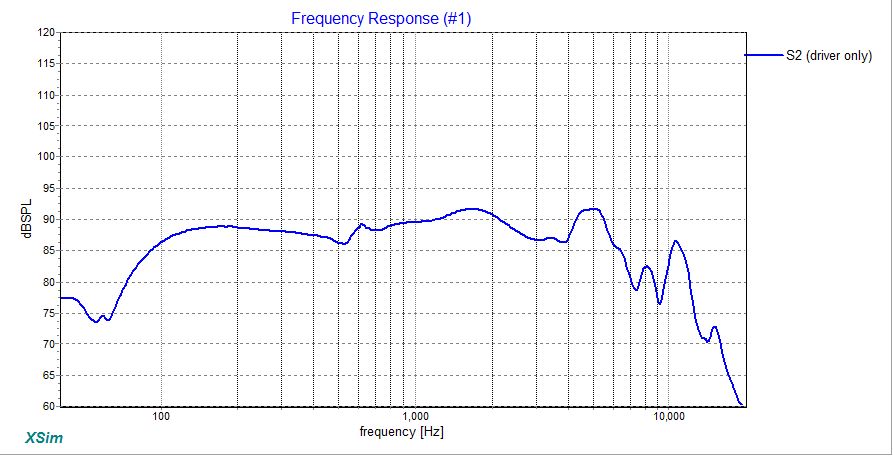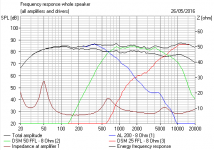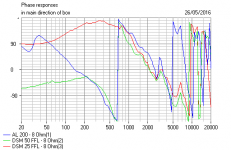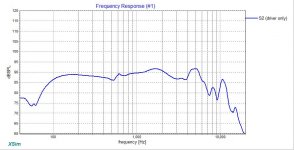Would this be considered time aligned?
CASABLANCA MK IV
Visaton doesn't write about it in the construction.
Though it looks very similar to some of Troels iterations.
AudioTechnology-3WC
Thank you for your time
CASABLANCA MK IV
Visaton doesn't write about it in the construction.
Though it looks very similar to some of Troels iterations.
AudioTechnology-3WC
An externally hosted image should be here but it was not working when we last tested it.
An externally hosted image should be here but it was not working when we last tested it.
Thank you for your time
Go by the back of the magnets as a rough guide. If they line up more or less then it probably is. Another test is to simulate the crossover in XSim with 0.0" of acoustic offset between the drivers. If you get ideal phase and frequency response then yes.
Another clue is the simplicity of the crossovers. Notice that the tweeter, woofer and midrange use very simple 2nd order filters. (with L Pads). This is usually only possible with very small speakers OR time aligned. Usually with a 3-way in a flat baffle you have to add more parts to turn the phase plots to align properly. What's a little odd though is that the tweeter is inverted in polarity.
Best,
Erik
Another clue is the simplicity of the crossovers. Notice that the tweeter, woofer and midrange use very simple 2nd order filters. (with L Pads). This is usually only possible with very small speakers OR time aligned. Usually with a 3-way in a flat baffle you have to add more parts to turn the phase plots to align properly. What's a little odd though is that the tweeter is inverted in polarity.
Best,
Erik
Without sounding ignorant I won't ask detailed questions like, "I thought designers do that to achieve a 180? So I just ask why do you think its weird.What's a little odd though is that the tweeter is inverted in polarity.
Troels did it to the midrange in his 3-Way Classic MKII?
Also a long time ago I read that you cannot rely on the physical aspect as this may be calculated incorrectly?
B.R.
Ho Moovnutz,
Inverting a tweeter is in fact a time-honored tradition! You are correct in that this trick is sometimes necessary to ensure accurate phase matching. That's not the problem.
You are correct in that this trick is sometimes necessary to ensure accurate phase matching. That's not the problem.
As Sonce correctly points out, if the speaker was accurately time aligned, this "trick" would not be necessary. It should be possible to achieve ideal phase matching with all drivers in polarity.
So, I'd guess that this speaker probably benefits from the acoustic delays, evident in the simple crossovers, but isn't completely time aligned. This is all forensic, after the crime happened conjecture though. Only measurements would tell us the complete truth.
Best,
Erik
Inverting a tweeter is in fact a time-honored tradition!
As Sonce correctly points out, if the speaker was accurately time aligned, this "trick" would not be necessary. It should be possible to achieve ideal phase matching with all drivers in polarity.
So, I'd guess that this speaker probably benefits from the acoustic delays, evident in the simple crossovers, but isn't completely time aligned. This is all forensic, after the crime happened conjecture though. Only measurements would tell us the complete truth.
Best,
Erik
As I have recently learned though, time aligned and transient perfect are not the same.
Time alignment leads us to design crossovers with an acoustic offset of 0 between the drivers. Transient perfect is that plus having the step response show a single triangular peak.
So for a time aligned speaker, with a very simple second order crossover the step response would look like this:
^___^___^___
With each driver having it's unique peak. With a transient perfect speaker you'd see this:
^\_____
One single peak followed by a long decay. Here is an example from a Vandersteen at Stereophile:
So, for sure we can say that the speakers you are looking at are not transient perfect. It's impossible for them to create this waveform with any driver out of polarity.
Time alignment leads us to design crossovers with an acoustic offset of 0 between the drivers. Transient perfect is that plus having the step response show a single triangular peak.
So for a time aligned speaker, with a very simple second order crossover the step response would look like this:
^___^___^___
With each driver having it's unique peak. With a transient perfect speaker you'd see this:
^\_____
One single peak followed by a long decay. Here is an example from a Vandersteen at Stereophile:
An externally hosted image should be here but it was not working when we last tested it.
So, for sure we can say that the speakers you are looking at are not transient perfect. It's impossible for them to create this waveform with any driver out of polarity.
Last edited:
Time aligned may mean simply that the above SR plot would have the leading edge falling sharply from the inverted tweeter so it would be aligned but not transient perfect and phase would be 180deg off. The sound would not be as good as transient perfect. Transient perfect can reproduce a square wave accurately. Inverted tweeter cannot and was used due to symmetric 2nd order XO between tweeter and mid.
One way to do it is 1st order XO like Dunlavey, or with hole-filler like B&O, or with Harsch XO (2nd order Bessel HPF and 4th order Butterworth LPF, same polarity).
Hole Filler XO:
http://www.diyaudio.com/forums/multi-way/88135-filler-driver-ala-b-o.html
Harsch XO:
http://www.diyaudio.com/forums/multi-way/277691-s-harsch-xo.html
Dunalavey:
Dunlavy Audio Labs SC-I loudspeaker Measurements | Stereophile.com
One way to do it is 1st order XO like Dunlavey, or with hole-filler like B&O, or with Harsch XO (2nd order Bessel HPF and 4th order Butterworth LPF, same polarity).
Hole Filler XO:
http://www.diyaudio.com/forums/multi-way/88135-filler-driver-ala-b-o.html
Harsch XO:
http://www.diyaudio.com/forums/multi-way/277691-s-harsch-xo.html
Dunalavey:
Dunlavy Audio Labs SC-I loudspeaker Measurements | Stereophile.com
The Visaton Casablanca MK IV:
CASABLANCA MK IV
I just had a dig at this in Boxsim. Because something was bothering me.
The acoustic centres of the DSM 50 FFL dome mids and the DSM 25 FFL tweeters are 10mm back from a flat baffle. The AL 200 is 53mm.
There is actually NO CASE for the stepped baffle whatsoever!
What worked best with 19mm chipboard, was putting the bass on the back of the baffle at 72mm, like the BBC used to, and putting the two other drivers on the front of the flat baffle. It's all then quite pretty, below. Believe me, it's worse with the stepped baffle.
Negative polarity at the top, because it's LR2. Positive polarity between bass and mid because it's highly assymetric.
A cone mid is a different matter. The acoustic centre is often 30mm back.
CASABLANCA MK IV
I just had a dig at this in Boxsim. Because something was bothering me.
The acoustic centres of the DSM 50 FFL dome mids and the DSM 25 FFL tweeters are 10mm back from a flat baffle. The AL 200 is 53mm.
There is actually NO CASE for the stepped baffle whatsoever!
What worked best with 19mm chipboard, was putting the bass on the back of the baffle at 72mm, like the BBC used to, and putting the two other drivers on the front of the flat baffle. It's all then quite pretty, below. Believe me, it's worse with the stepped baffle.
Negative polarity at the top, because it's LR2. Positive polarity between bass and mid because it's highly assymetric.
A cone mid is a different matter. The acoustic centre is often 30mm back.
Attachments
inverted tweeter polarity speaks against Time-aligning
Transient perfect can reproduce a square wave accurately. Inverted tweeter cannot
That's not exactly true. You can have transient perfect (or as close as any speaker gets, which isn't 'perfect' of course) with an inverted tweeter or midrange, sometimes it's the only way to do it with passive. For the tweeter, the initial downward-going edge can be part of the 'pre-ring' of which some 'philes obsess, but a necessary feature when you have both flat magnitude and phase linearity to high frequencies that is then followed by a relatively sudden drop (or use measurement gear that has sudden blindness above a given frequency, pretty much all FFT based systems). The edge may also be partly absorbed into the midrange's IR or even the bass's.
The crossover, and the phase shifts and filter slopes that are part of every driver's raw characteristic cause a lot of phase shift to work around and you only need the driver to be resulting 'non-inverting' in it's passband, the phase/polarity outside don't matter. Being narrowband, you can effectively re-invert with added phase slopes and delays (time of flight or all-pass).
My CoSyne v1 had both the midrange and tweeter inverted (hard to tell, though since the tweeter runs through an all-pass and 'loses' the ground contact), but does pretty decent square waves. (see attached design file)
Attachments
Thanks for that explanation Bwaslo. The mid sitting inside a band pass injection port does weird things. I have see the chamber and port flip the acoustic phase (probably due to 180 deg acoustic delay). On a simple 2 way open face speaker - I am quite sure I can tell when a xo uses flipped tweeter. But maybe a different story when in a horn.
I should add that, for diyers doing the whole system (not just a speaker to hook up to a receiver), making a linear phase 'transient perfect' crossover is crazy talk. Design the speaker for best response flatness and (particularly) best off-axis behavior, and then use a DSP FIR-type equalizer to make it more linear phase than you'll ever get to by going strictly passive. IMSHO, of course.
Thanks for that explanation Bwaslo. The mid sitting inside a band pass injection port does weird things. I have see the chamber and port flip the acoustic phase (probably due to 180 deg acoustic delay). On a simple 2 way open face speaker - I am quite sure I can tell when a xo uses flipped tweeter. But maybe a different story when in a horn.
That might be also partly because it implies they used second-order overall crossover slopes, which has consequences in the polar patterns.
I should add that, for diyers doing the whole system (not just a speaker to hook up to a receiver), making a linear phase 'transient perfect' crossover is crazy talk. Design the speaker for best response flatness and (particularly) best off-axis behavior, and then use a DSP FIR-type equalizer to make it more linear phase than you'll ever get to by going strictly passive. IMSHO, of course.
I'm all for letting the signal processor do the hard work, but not sure how I could call a speaker with an inverted tweeter transient perfect.
It may be audibly indistinguishable from the alternative though.
Best,
Erik
I was reading about the Dunlavy SC-1. A stepped MTM closed box designed for good step response. 6dB filters apparently.
Dunlavy Audio Labs SC-I loudspeaker | Stereophile.com
Drivers, I think are these:
Vifa P13WH-00-08 Tymphany P13WH-00 5" Woofer
Vifa D27TG35-06 Peerless by Tymphany D27TG35-06 1" Silk Dome Tweeter
Not much bass, of course, and not a million miles away from Lynn Olson's Ariel. I can see how that would work. Try and get those flat Vifa P13WH woofers these days, though.
Dunlavy Audio Labs SC-I loudspeaker | Stereophile.com
Drivers, I think are these:
Vifa P13WH-00-08 Tymphany P13WH-00 5" Woofer
Vifa D27TG35-06 Peerless by Tymphany D27TG35-06 1" Silk Dome Tweeter
Not much bass, of course, and not a million miles away from Lynn Olson's Ariel. I can see how that would work. Try and get those flat Vifa P13WH woofers these days, though.
Hey Steve,
The current crop of Peerless 5 1/4" truncated frame woofers isn't bad at all! It's not that flat, but incredibly smooth for the price points, priced between $20 for paper to $45 for the woven fiberglass.
Please see the in-cabinet response if the 830991 below. Nearfield spliced in at 600 Hz. 1/24th octave smoothing, and I'm still missing the port contributions. Yes, the Vifa you lament was probably better though.
That raggedness you see around 600 Hz is not a bad splice, it's in both near and farfield, so I chose it.

The current crop of Peerless 5 1/4" truncated frame woofers isn't bad at all! It's not that flat, but incredibly smooth for the price points, priced between $20 for paper to $45 for the woven fiberglass.
Please see the in-cabinet response if the 830991 below. Nearfield spliced in at 600 Hz. 1/24th octave smoothing, and I'm still missing the port contributions. Yes, the Vifa you lament was probably better though.
That raggedness you see around 600 Hz is not a bad splice, it's in both near and farfield, so I chose it.
Attachments
Last edited:
how I could call a speaker with an inverted tweeter transient perfect.
if the speaker was accurately time aligned, this "trick" would not be necessary.
There is no trick. The symmetrical filters would be (if the crossover was deliberate and reasonable), a sign that the drivers are aligned, and the polarity reversal is not incorrect. Aligning them for in polarity operation introduces excess group delay and response anomalies.Notice that the tweeter, woofer and midrange use very simple 2nd order filters. (with L Pads). This is usually only possible with very small speakers OR time aligned.
Time alignment and transient perfectness are two things, and not strictly necessary within certain limits. They can become a red herring to the optimum crossover, and like signal processing they only 'fix' things at one point.
I was reading about the Dunlavy SC-1. A stepped MTM closed box designed for good step response. 6dB filters apparently.
Dunlavy Audio Labs SC-I loudspeaker | Stereophile.com
Drivers, I think are these:
Vifa P13WH-00-08 Tymphany P13WH-00 5" Woofer
Vifa D27TG35-06 Peerless by Tymphany D27TG35-06 1" Silk Dome Tweeter
Not much bass, of course, and not a million miles away from Lynn Olson's Ariel. I can see how that would work. Try and get those flat Vifa P13WH woofers these days, though.
I think a Tymphany M-130 5.25in woofer would be a great starting point. It's flat response will allow simple 1st order XO.
M130 Woofer
90dB and $27
An externally hosted image should be here but it was not working when we last tested it.
Pair it with a Vifa TS26G:
http://gr-research.com/gr-t3tweeter-1.aspx
An externally hosted image should be here but it was not working when we last tested it.
With two flat responses like the above it should be easy to put together a first order XO. The tweeter will probably need about a 3in setback for time alignment.
Last edited:
- Status
- This old topic is closed. If you want to reopen this topic, contact a moderator using the "Report Post" button.
- Home
- Loudspeakers
- Multi-Way
- Time aligned ???


